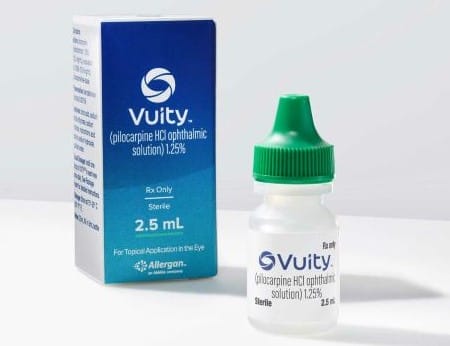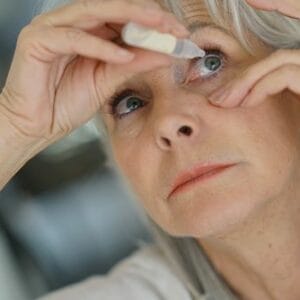June 20, 2023
For most patients, newer technology, advancements in surgery, and pharmacological breakthroughs may seem to appear too late after they have already undergone cataract surgery. This may be true as it pertains to the specific lens that is implanted, although rarely a lens can be replaced. Yet, the combination of different modalities can ensure that patients who do not have a multifocal, extended depth of focus (EDOF), or trifocal intraocular implant could still get the clarity at near without the constant need for glasses or contacts. Skeptical? Doubtful? Here’s how this may be a reality with today’s treatments.
In December of 2021, AbbVie, the parent company of Allergan, brought to market the first-in-class topical treatment for presbyopia. This single drop medication has the unique property of creating a miotic pupil there by extending the depth of focus. In 2023, the company added an opportunity to safely and efficaciously add a second dose to extend the time of clarity patients will achieve. Now, unlike the magnification that is achieved by spectacles, the vision through a miotic pupil enhances sharpness rather than the size. Moreover, the clinical data demonstrated that patients did not lose more than one logMAR of distance visual acuity.
Haters are going to point me, rightfully so, to the inclusion criteria that the original FDA clinical trial used for approval: -4.00D to +1.00 DS, with less than -2.00D of cylinder, for all of the clinical trials. Furthermore, the patients were younger than 55 with a healthy retina, and they could not have a pseudophakic implant. Before you raise your eyebrow regarding the lack of pseudophakes, allow me to explain. The indication that this miotic has is quite simply, “For the treatment of presbyopia in adults.” That is a broad definition, my friends. Not phakic presbyopes, not presbyopes that were moderate myopes or barely hyperopic, simply anyone who is over 18 years of age, and regardless of any other factors, who have brought our patient to the brink of decreased best corrected near vision.
Schedule Time to Provide Presbyopia Education
I am struck by the fact we rarely ever take the two minutes (yes, this conversation is quite succinct and easily done) to educate patients about presbyopia, especially since we can finally help them see without spectacles or contacts. Think about your presbyopia discussion, when you do have one. Doesn’t the core of the discussion pivot around telling patients they can’t see near-related tasks because the lens doesn’t help? Although this is true, it misses the fact that the pupil is also constricting, and the eyes converge. When I explain that the pupils are getting smaller and this induces an extension of their clear vision, especially at near, it also gives me the option to discuss the other benefits associated with extended depth of vision (EDOV), namely reduced glare and the blur circle. Glare, blur, and reduced focal points are all chief complaints that I have heard from my pseudophakic population for as long as I have been practicing.
Since we have not had the luxury of offering our patients presbyopic-correcting near IOL’s for all that long, all of us have patients who never knew they even existed. Furthermore, these lens options may not be an option, secondary to corneal or retinal issues, and the cost may be prohibitive to contemporary patients. Let’s be honest, patients want the luxury of seamless vision, and they think they are going to have it regardless. The opportunity to have clearer distance vision following cataract surgery, as well as not being tethered to spectacles to see their phone or read a menu, is one our patients would cherish. Thus, that two-minute conversation is a nugget of wisdom and a practice-building offering for your near-afflicted pseudophakes. When I walk into a lane, I look at the spectacle needs of my patients and determine if they are a presbyopes. I ensure they have a healthy retina, and then I simply ask if they would be interested in hearing how a new ocular drop could alleviate the need for spectacles for hours of their day, with little to no side effects. The application of the Vuity drop is also somewhat selfish, since I know that the EDOV’s sequelae will nullify the other visual complications my pseudophakic patients may also be encountering.
This first-in-class medication has only been out a little under a year and half, thus we are still finding marvel applications for its use. The pseudophakic eye should not be overlooked, nor should the post-refractive, when considering the use of Vuity or rather the ability to enhance their near and very critical intermediate vision. It is not for us to assume our pseudophakic patients would not want to experience the clarity that this novel pharmaceutical could provide; rather it should be our duty to inform them of the clarity it might bring to their world.





